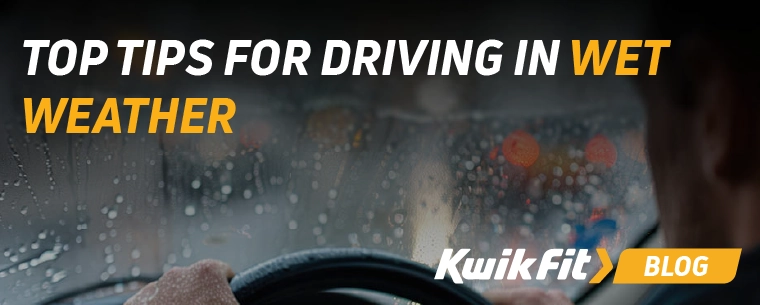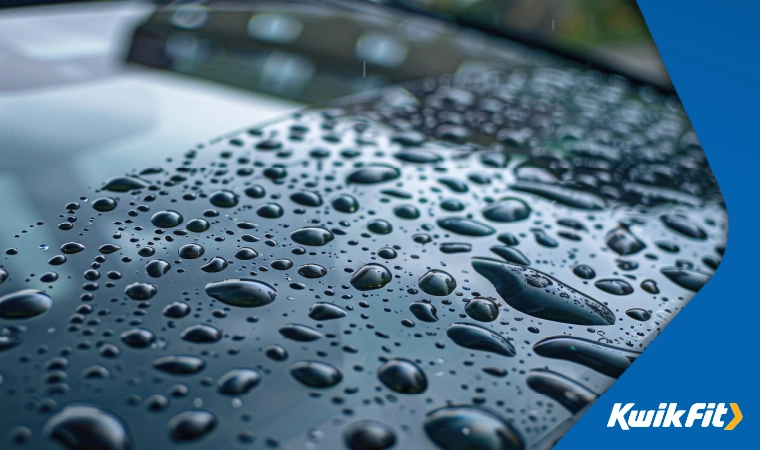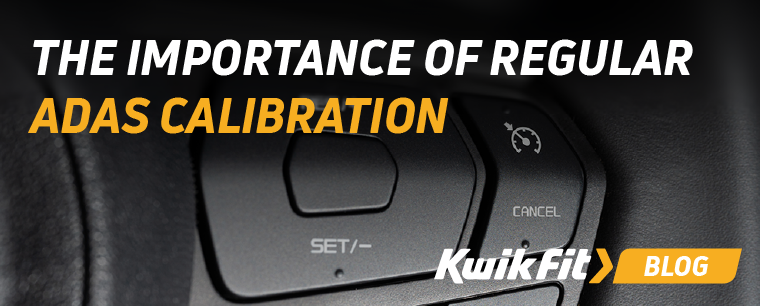Wet Weather Driving Tips – Staying Safe in the Rain
Jack Dreyer | Friday 29th November 2024 8:00am

If you’re planning a drive and it has started raining, be careful before setting off. Rain, and particularly an unexpected downpour, can make driving more hazardous for a number of reasons. Reduced grip can make stopping distances longer, and you’re at an increased risk of aquaplaning if you need to make an emergency stop.
Here are some tips for driving in wet weather and to help you get where you’re going, safely.
What to do before setting off
Before any drive, it’s important to make a few checks – but it’s especially so before driving in heavy rain or wet conditions. Run through these the following pre-driving checks to ensure a smoother journey.
Consider whether your journey’s necessary
Depending on the time of year that it’s raining, it’s worth really considering whether you absolutely need to leave right now. Check the weather forecast and try to establish whether waiting for a little time will allow the weather to clear up. It’s amazing how quickly showers (and even a sudden, heavy downpour) can move on sometimes!
Check your wipers & screen wash
Your wipers might seem like insignificant parts of your car, but it’s actually a legal requirement to ensure that your front and rear windscreens are kept clear at all times.
Something as simple as spray or mud from the road surface can significantly reduce visibility and put you in a dangerous situation. So be sure to check that the windscreen wipers work on all settings and that your screen wash is topped up.
Check your fuel
With wetter weather comes more traffic as people slow down for safety. Driving in lower gears is safer but also dramatically increases fuel consumption – be sure to check your fuel gauge when you start your car in case you need to make a pit stop to fill up.
Listen out for traffic updates
Navigation tools like Google Maps will often feature real time updates for congestion and accidents. Most cars are fitted with RDS, or Radio Data System, which enables traffic reports to be received more easily.
However, it’s always worth keeping an ear out for announcements on local radio stations a little before heading off and while driving – if you can bear the music, that is!
Keep your phone charger in your car
Getting stuck in traffic (or worse), in bad weather, with a dead phone is a rain on anyone’s parade. Be sure to keep a spare phone charger in your car, and even a spare portable power bank for good measure! It’s crucial to be able to call for help, or even just to alert friends that you’ll be late to a planned event. However, don’t forget to only ever use your phone hands free when driving.
Take an emergency kit with you
As well as your phone, it’s also a good idea to take an emergency kit with you. This should include a warm, waterproof jacket, water, snacks and a torch. You may never need it, but you’ll be pleased you’ve got it, should you break down or end up having to stop due to flooding or an accident.
Check your tyres
It’s really important to check your tyres before driving in wet weather. The tread depth of your tyres is directly responsible for channelling water away from your tyres and keeping you firmly in contact with the road. Here’s a full guide on checking your tyres before heading off.
Tips for driving in wet weather
So, once you’ve established it’s necessary to drive and that it’s safe to do so, it’s worth keeping some crucial tips in mind.
Slow down
The most important thing when driving in rain, ice, or snow is to slow down. Driving at high speeds increases stopping distances simply because there’s more momentum for your brakes & tyres to slow down.
But stopping distances in wet weather can increase almost exponentially. So be sure to reduce your speed in order to give yourself time to react to hazards.
Visibility – turn on your headlights
Be sure to turn on your dipped headlights – even in the daytime – as visibility is reduced in the rain. That said, don’t be tempted to switch on your rear fog lights as this can dazzle drivers behind you and make it more difficult for them to drive safely.
Also look out for spray created by large or fast vehicles - the spray kicked up by a lorry, coupled with the rain already falling, can quickly cover your windshield.
To stop your windows misting up, put your car’s heating on – though air con works to dehumidify too!
Look out for puddles
Keep an eye out for large puddles of water as driving through these too quickly can not only cause damage to your vehicle but also splash pedestrians or other vehicles. Driving too fast through water can also lead to your tyres losing grip and your vehicle aquaplaning. If you feel yourself going into a skid, ease off the accelerator until you regain control.
After you’ve driven through standing water, you should test your brakes to make sure that they are still functioning as they should. You can do this by driving slowly and lightly pressing your brakes, taking care to check that there are no other vehicles in close proximity.
Keep your distance
Maintain a safe distance between your vehicle and the vehicle in front. Increased stopping distances mean that a greater distance is required to give you time to react.
You should also avoid braking harshly, as this can be unsafe on wet roads.
Be careful at junctions
You should also take extra care at junctions as water can build up here, as well as vehicle fluids which can cause a major skid risk. Therefore, you should approach junctions at a low speed, remaining aware of everything going on around you – you may be driving safely but you need to be aware of others who may not be.
Maintain a good grip on the steering wheel
Heavy rain is often accompanied by strong winds, so make sure that you are in control of your vehicle with a good grip on the steering wheel. It is best to be prepared for a sudden gust of wind to prevent you being taken by surprise and unable to react quickly enough.
Keep your AC on to prevent your windows from misting up
In humid conditions, your windows can mist up really quickly. When you’re travelling at a relatively fast speed on a motorway in heavy rain, with spray all around you, your visibility could be reduced to almost nothing. But it’s important not to panic in these situations.
If you learn how to quickly and calmly de-mist your windows, there’s no need to feel anxious. Simply switch your heater on (with the windscreen setting selected) and slowly increase the temperature, then put the air con on at the same time to keep the atmosphere dry.
If your car is equipped with an air con or climate control setting, use it. If you’re travelling with someone else, ask them to use the temperature controls so that you can concentrate on the road.
Flooding
An extended period of heavy rain or a sudden downpour inevitably leads to flooding in some areas. Some roads near rivers often flood and these will have markers which indicate how deep the standing water is.
However, in other areas that are less prone to flooding, there won’t be any indicator as to how deep the water is. In these cases, if the water looks deep and you’re unsure, it’s usually best to see if there is another route you can take.
If you do have to drive through standing water, ensure that you take it slowly as you could cause problems for other road users or damage to your own vehicle. If your engine gets waterlogged, this can lead to engine failure.

Breaking down in the rain
Vehicles break down in the rain for a few reasons. The rain and damp can stop engines and electrical systems working properly, and people driving fast through deep water can flood their engines.
If your engine stops operating after such a situation, you should avoid trying to start it again as this can cause further damage. Put your hazards on and call your breakdown service instead. While waiting for assistance, keep the bonnet closed to stop further moisture getting in.
Get a free vehicle safety check with Kwik Fit
If you want further peace of mind that your car will reliably make it through winter storms or summer downpours, book a free vehicle safety check at your local Kwik Fit Centre. Our friendly technicians will test the battery, inspect your tyres, check your fluid levels, and even give your wipers an inspection to ensure they’re working properly. Plus, with over 600 locations across the UK, you’ll be sure to find a Kwik Fit centre near you.
Any facts, figures and prices shown in our blog articles are correct at time of publication.
Featured Articles
10 things that can affect your stopping distance
Sunday 6th April 2025
From tread depth to tiredness, read on to learn about 10 factors that can impact your braking distance. Stay safe on the roads with Kwik Fit.
What’s The Difference Between An MOT And A Service?
Tuesday 25th March 2025
Car service vs MOT? Learn the core differences between these two crucial types of vehicle maintenance in our informative blog written by experts.
The Importance of Regular ADAS Calibration
Monday 9th September 2024
Want to know why ADAS calibration is important for vehicle safety & performance? Read our blog to learn more about the impacts of not calibrating your ADAS.









